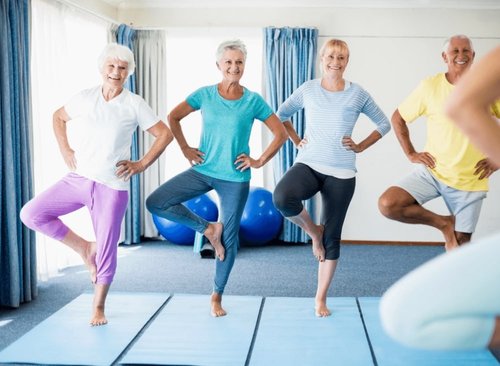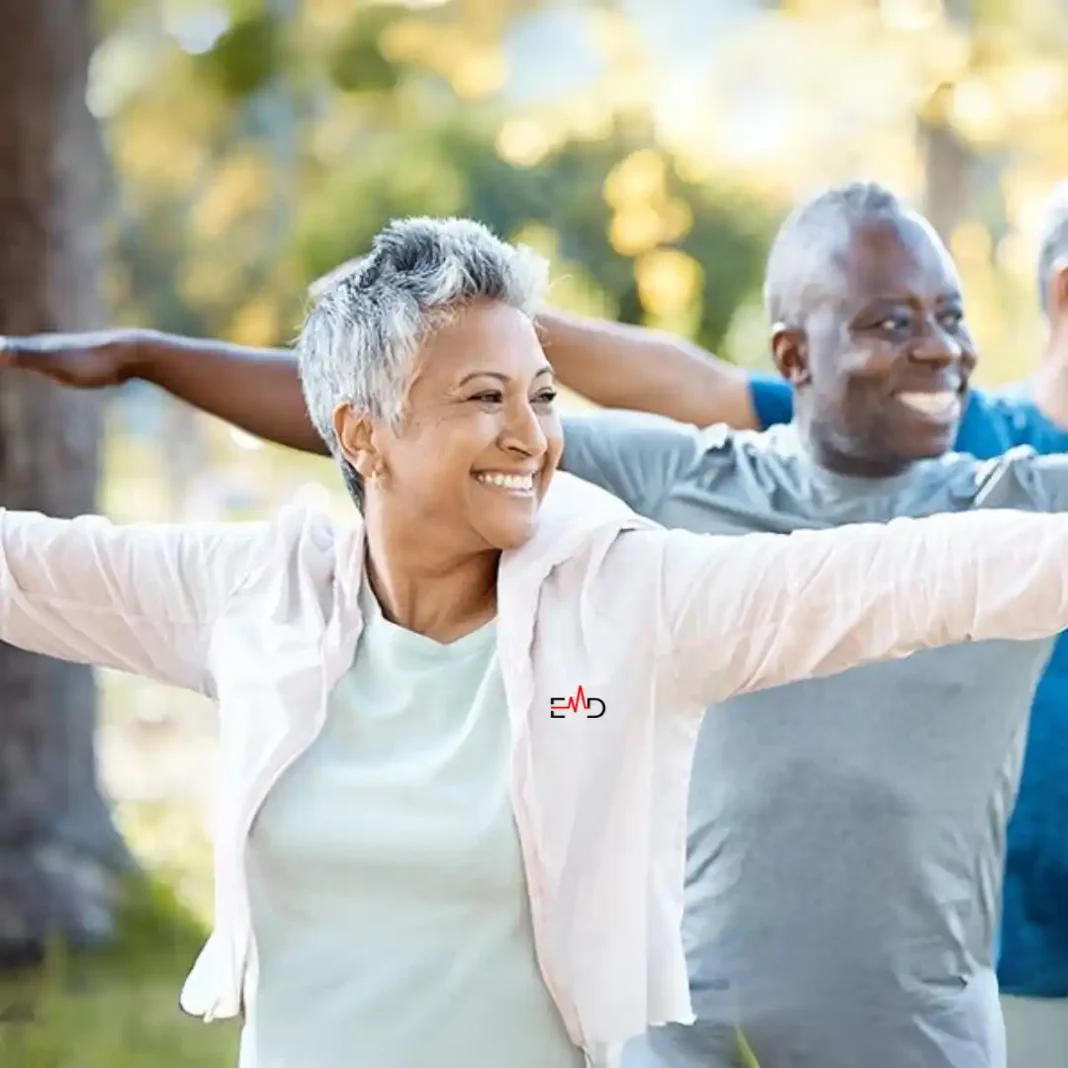Exercise Daily – Maintaining our health becomes more important as we age. Healthy aging doesn’t just mean avoiding disease but also staying active, mentally sharp, and connected. Embracing a holistic approach to wellness can significantly enhance the quality of life in our later years. Here are essential tips for healthy aging that focus on physical, cognitive, and emotional well-being.
Maintaining fitness and well-being becomes crucial as athletes age for preserving their performance levels and overall health. One essential tip is to focus on incorporating flexibility and mobility exercises. While younger athletes often prioritize strength and speed, older athletes should emphasize activities like yoga or dynamic stretching to support joint health and prevent injuries. Regular mobility exercises not only improve flexibility but also ensure that the body remains agile and adaptable as it ages. Additionally, balancing strength training with low-impact cardiovascular exercises, like swimming or cycling, helps maintain cardiovascular health while reducing strain on joints, allowing athletes to stay fit without risking injury.
What is Healthy Aging?
Healthy aging involves making lifestyle choices supporting physical and mental wellness as we age. It encompasses maintaining independence, vitality, and mental agility, allowing individuals to live fulfilling lives well into their senior years. According to the National Institute on Aging, several factors contribute to healthy aging, including regular exercise, balanced nutrition, mental stimulation, and strong social connections.
The Pillars of Healthy Aging
- Physical Health: Maintaining a strong and flexible body through regular exercise and proper nutrition.
- Cognitive Health: Keeping the mind active and engaged to prevent cognitive decline.
- Emotional Well-being: Managing stress, maintaining positive relationships, and fostering a sense of purpose.
- Social Connections: Building and maintaining relationships to prevent loneliness and promote mental health.
- Preventive Healthcare: Regular health screenings and proactive management of chronic conditions.
Understanding these pillars helps create a comprehensive plan for healthy aging, addressing various aspects of life to ensure overall well-being.

Physical Health for Older Adults
Maintaining physical health is essential to live longer and better as you get older. Regular movement helps prevent muscle loss, keeps the heart healthy, and reduces the risk of chronic illnesses. Let’s dive into why physical health is crucial and which exercises benefit older adults.
Importance of Physical Health
Staying physically fit can prevent issues like osteoporosis, high blood pressure, and cardiovascular disease. Research shows that physical activity improves both the quality and longevity of life, making it key to aging well. Physical health also supports mobility, balance, and the ability to perform daily activities independently, which is vital for maintaining a high quality of life.
Benefits of Physical Fitness in Aging
- Enhanced Mobility: Regular exercise maintains joint flexibility and muscle strength, reducing the risk of falls and injuries.
- Cardiovascular Health: Physical activity strengthens the heart, lowers blood pressure, and improves circulation.
- Weight Management: Maintaining a healthy weight reduces the risk of diabetes, heart disease, and other chronic conditions.
- Bone Health: Weight-bearing exercises strengthen bones, preventing osteoporosis and fractures.
- Mental Health: Physical activity releases endorphins, which can improve mood and reduce symptoms of depression and anxiety.
Exercise Routines for Older Adults
Simple exercises such as walking, yoga, and strength training are ideal for older adults. Aim for 150 minutes of moderate exercise each week, including balance and flexibility training to reduce the risk of falls. Tailoring exercise routines to individual abilities and preferences can enhance adherence and enjoyment.
Types of Exercises
- Aerobic Exercises: Activities like walking, swimming, and cycling that increase heart rate and improve cardiovascular health.
- Strength Training: Using weights or resistance bands to build muscle mass and strength, which helps maintain mobility and prevent muscle loss.
- Flexibility Exercises: Stretching and yoga improve flexibility, reducing stiffness and enhancing the range of motion.
- Balance Training: Practices such as tai chi and specific balance exercises help prevent falls by improving stability and coordination.
- Low-Impact Activities: Gentle exercises like water aerobics and chair exercises are suitable for those with joint issues or limited mobility.
Creating a Sustainable Exercise Plan
Developing a consistent exercise routine is crucial for long-term benefits. Here are some tips to create a sustainable plan:
- Set Realistic Goals: Start with manageable goals and gradually increase intensity and duration.
- Incorporate Variety: Mix different types of exercises to keep the routine interesting and work different muscle groups.
- Listen to Your Body: Pay attention to your body’s signals and avoid overexertion to prevent injuries.
- Stay Consistent: Make exercise a regular part of your daily routine to establish lasting habits.
- Seek Professional Guidance: Consult with a healthcare provider or a fitness professional to design a safe and effective exercise plan tailored to your needs.

Nutritional Tips to Age Well
Eating a healthy diet filled with nutrient-rich foods is another cornerstone of healthy aging. Not only does good nutrition fuel the body, but it also helps in managing weight, preventing disease, and promoting longevity.
Healthy Eating for a Long Life
Focus on a diet high in fruits, vegetables, whole grains, lean proteins, and healthy fats. Reducing processed foods, sugars, and unhealthy fats can prevent diseases and keep you feeling young and energetic.
Key Nutritional Strategies
- Balanced Diet: Ensure a balance of macronutrients (carbohydrates, proteins, and fats) and micronutrients (vitamins and minerals) to support overall health.
- Portion Control: Managing portion sizes helps maintain a healthy weight and prevents overeating.
- Hydration: Staying well-hydrated is essential for all bodily functions, including digestion and cognitive performance.
- Fiber Intake: High-fiber foods like vegetables, fruits, and whole grains aid in digestion and prevent constipation.
- Limit Processed Foods: Reduce consumption of processed and sugary foods that contribute to weight gain and chronic diseases.
Foods That Boost Longevity
Fruits and vegetables, particularly leafy greens and berries, are packed with antioxidants that help combat aging. Foods like salmon, nuts, and olive oil are excellent sources of healthy fats that support brain health and reduce inflammation.
Superfoods for Healthy Aging
- Leafy Greens: Spinach, kale, and broccoli are rich in vitamins, minerals, and antioxidants that support overall health.
- Berries: Blueberries, strawberries, and raspberries contain high levels of antioxidants that protect against cellular damage.
- Fatty Fish: Salmon, mackerel, and sardines provide omega-3 fatty acids, which are beneficial for heart and brain health.
- Nuts and Seeds: Almonds, walnuts, and chia seeds offer healthy fats, protein, and fiber, supporting cardiovascular and metabolic health.
- Whole Grains: Oats, quinoa, and brown rice provide sustained energy and promote digestive health.
- Olive Oil: A staple in the Mediterranean diet, olive oil is rich in monounsaturated fats and has anti-inflammatory properties.
- Legumes: Beans, lentils, and chickpeas are excellent sources of plant-based protein and fiber, aiding in muscle maintenance and digestive health.
Meal Planning and Preparation
Effective meal planning and preparation can ensure a balanced diet and prevent unhealthy eating habits.
- Plan Ahead: Create a weekly meal plan to incorporate a variety of nutrient-dense foods.
- Cook at Home: Preparing meals at home allows for better control over ingredients and portion sizes.
- Healthy Snacking: Choose healthy snacks like fruits, nuts, and yogurt instead of processed snacks.
- Mindful Eating: Pay attention to hunger and fullness cues to prevent overeating and promote better digestion.
- Supplements: Consult with a healthcare provider about necessary supplements, such as vitamin D, calcium, or B12, to address specific nutritional needs.
Regular Health Screenings and Checkups
Regular health screenings are critical in identifying and managing health risks early. They provide a proactive approach to maintaining health as you age, ensuring that potential issues are addressed before they become serious.
Why Health Screenings Matter
Early detection can make a huge difference in managing health issues. Routine screenings help monitor risk factors for conditions like high blood pressure, diabetes, and cancer, allowing for timely intervention and treatment.
Advantages of Regular Health Screenings
- Early Detection: Identifying diseases in their early stages increases the chances of successful treatment.
- Preventive Care: Screenings can detect risk factors, enabling preventive measures to be taken before conditions develop.
- Personalized Health Plans: Regular checkups provide personalized insights into your health, allowing for tailored health strategies.
- Peace of Mind: Knowing that you are regularly monitored can reduce anxiety about potential health issues.
Key Screenings for Older Adults
Important screenings include blood pressure checks, cholesterol tests, bone density screenings, and eye exams. Talk to your doctor to ensure you’re current on these essential checks.
Essential Health Screenings
- Blood Pressure Monitoring: Regular checks help detect hypertension, which can lead to heart disease and stroke if untreated.
- Cholesterol Testing: Identifies abnormal cholesterol levels, allowing for dietary and lifestyle adjustments to prevent cardiovascular disease.
- Bone Density Tests: Screen for osteoporosis, helping to prevent fractures and maintain bone health.
- Cancer Screenings: Depending on age and risk factors, screenings for colorectal, breast, prostate, and skin cancer are recommended.
- Diabetes Screening: Early detection of diabetes can prevent complications through diet, exercise, and medication.
- Vision and Hearing Tests: Regular exams ensure that any sensory impairments are addressed promptly, enhancing quality of life.
- Immunizations: Staying up to date with vaccinations, such as the flu shot and shingles vaccine, helps prevent illness and complications.
Developing a Preventive Health Strategy
Creating a comprehensive health strategy involves:
- Regular Appointments: Schedule routine visits with your primary care physician and specialists as needed.
- Personal Health Records: Maintain an updated record of your medical history, medications, and screening results.
- Lifestyle Modifications: Implement changes based on screening results, such as adopting a healthier diet, increasing physical activity, or quitting smoking.
- Medication Management: Ensure that all medications are taken as prescribed and discuss any side effects or concerns with your healthcare provider.

Emotional and Social Wellness
Mental health is an important component of healthy aging. Keeping social connections and managing stress are vital to maintaining emotional well-being. Emotional and social wellness contributes to overall happiness and resilience, helping older adults navigate the challenges of aging with grace and positivity.
Maintaining Social Connections
Engaging with friends and family or joining community groups reduces feelings of loneliness and enhances happiness. Social connections have been shown to improve overall health and reduce cognitive decline. Building a strong support network fosters a sense of belonging and purpose, which are essential for emotional health.
Strategies for Social Engagement
- Join Clubs and Organizations: Participate in local clubs, hobby groups, or volunteer organizations to meet like-minded individuals.
- Stay Connected with Family: Regularly communicate with family members through phone calls, video chats, or in-person visits.
- Attend Community Events: Participate in local events, such as fairs, concerts, and workshops, to stay active in the community.
- Use Technology: Leverage social media and communication apps to stay in touch with distant friends and family.
- Engage in Group Activities: Join exercise classes, book clubs, or art groups to foster social interactions and shared interests.
- Volunteer: Offering time and skills to community services or charitable organizations provides a sense of purpose and connection.
Managing Stress and Staying Positive
Practicing mindfulness, meditation, and gratitude can help manage stress. Staying optimistic and focusing on what you can control contributes to emotional resilience. Developing coping strategies and maintaining a positive outlook enhance mental well-being and overall quality of life.
Techniques for Stress Management
- Mindfulness Meditation: Practicing mindfulness helps stay present and reduces anxiety by focusing on the current moment.
- Deep Breathing Exercises: Simple breathing techniques can alleviate stress and promote relaxation.
- Gratitude Journaling: Writing down things you are grateful for can shift focus from negative to positive aspects of life.
- Physical Activity: Exercise is a natural stress reliever, releasing endorphins that improve mood and reduce anxiety.
- Social Support: Talking to friends, family, or a counselor provides emotional support and reduces feelings of isolation.
- Hobbies and Interests: Engaging in enjoyable activities can distract from stressors and enhance happiness.
- Adequate Rest: Ensuring sufficient sleep and rest helps in managing stress and maintaining emotional balance.
Building Emotional Resilience
Emotional resilience is the ability to adapt to stress and adversity. Building resilience involves:
- Developing a Positive Mindset: Focusing on positive outcomes and maintaining hope even in difficult situations.
- Flexibility: Being open to change and willing to adapt to new circumstances.
- Problem-Solving Skills: Approaching challenges with a proactive and solution-oriented mindset.
- Self-Care: Prioritizing activities that promote physical, emotional, and mental well-being.
- Seeking Help When Needed: Recognizing when to seek professional help for emotional or mental health issues.
Tips to Stay Active as You Age
Physical activity is beneficial at any age. Regular movement can prevent muscle deterioration, boost mood, and support mobility. Staying active also enhances independence and the ability to easily engage in daily activities. Here are some easy ways to keep moving.
Benefits of Staying Active
Besides the physical perks, staying active improves mental health, helping you feel alert, happy, and engaged with life. Active individuals tend to have better sleep patterns, higher energy levels, and greater well-being.
Comprehensive Benefits
- Improved Physical Health: Enhances strength, flexibility, and cardiovascular health.
- Mental Clarity: Promotes better cognitive function and reduces the risk of mental decline.
- Emotional Stability: Releases endorphins that elevate mood and reduce stress.
- Social Interaction: Engaging in group activities fosters connections and reduces loneliness.
- Enhanced Mobility: Maintains the ability to move freely and perform daily tasks independently.

Fun Ways to Keep Moving
Gardening, dancing, or playing with grandchildren are enjoyable ways to stay active. Even small changes, like taking the stairs, go a long way in keeping fit. Incorporating activities you love ensures that staying active is a pleasurable part of your routine.
Engaging Activities
- Gardening: Combines physical activity with the joy of nurturing plants and being outdoors.
- Dancing: A fun way to improve coordination, balance, and cardiovascular health.
- Playing with Grandchildren: Interactive play provides physical movement and strengthens family bonds.
- Walking Tours: Exploring local parks, trails, or city sights offers exercise and mental stimulation.
- Swimming: A low-impact exercise that is easy on the joints and great for overall fitness.
- Cycling: Riding a bike, outdoors or stationary, promotes leg strength and cardiovascular health.
- Yoga and Tai Chi: Gentle practices that enhance flexibility, balance, and mental focus.
- Home Exercises: Incorporate simple exercises like stretching, leg lifts, or chair exercises into your daily routine.
Incorporating Activity into Daily Life
Making small adjustments to your daily routine can significantly increase your activity levels without requiring a structured exercise regimen.
- Active Transportation: Walk or bike instead of driving for short trips.
- Household Chores: Stay active in activities like cleaning, gardening, or organizing.
- Standing Desks: Use a standing desk or take regular breaks to stand and stretch if you work from home.
- Scheduled Activity Time: Set aside specific times each day for physical activity to establish a routine.
- Buddy System: Exercise with a friend or family member to stay motivated and accountable.
Avoiding Common Health Problems in Later Years
As you grow older, the risk of certain health issues like heart disease and high blood pressure increases. Taking preventive measures can help reduce these risks and promote a healthier, more active lifestyle.
Preventing Heart Disease and High Blood Pressure
Reducing sodium intake, exercising regularly, and managing stress can help keep your heart and blood vessels in shape. Regular checkups to monitor these conditions are crucial for early detection and management.
Strategies for Heart Health
- Healthy Diet: Emphasize whole grains, lean proteins, fruits, and vegetables while limiting salt, sugar, and unhealthy fats.
- Regular Exercise: Engage in aerobic activities that strengthen the heart and improve circulation.
- Weight Management: Maintaining a healthy weight reduces the strain on the heart and lowers blood pressure.
- Limit Alcohol Consumption: Excessive alcohol intake can raise blood pressure and contribute to heart disease.
- Quit Smoking: Smoking cessation significantly lowers the risk of heart disease and improves overall health.
- Stress Management: Practice relaxation techniques to reduce stress, which can negatively impact heart health.
Managing Chronic Health Conditions
If you have a chronic illness, working closely with your healthcare provider to manage it can prevent complications. Managing blood sugar, cholesterol, and weight is crucial to maintaining health and preventing further issues.
Effective Chronic Disease Management
- Medication Adherence: Take prescribed medications as directed and discuss any side effects with your doctor.
- Regular Monitoring: Keep track of vital signs and relevant health metrics to monitor disease progression and treatment effectiveness.
- Healthy Lifestyle Choices: Adopt a balanced diet, exercise regularly, and avoid harmful habits like smoking and excessive drinking.
- Education and Awareness: Stay informed about your condition and understand the best management practices.
- Support Systems: Join support groups or seek counseling to help cope with the emotional and psychological aspects of chronic illness.
- Collaborative Care: Work with a multidisciplinary healthcare team, including doctors, nurses, dietitians, and physical therapists, to ensure comprehensive care.
Preventive Measures for Common Health Issues
Proactively addressing potential health issues can prevent them from developing or worsening.
- Vaccinations: Stay up to date with recommended vaccines to prevent infectious diseases.
- Healthy Weight Maintenance: Avoid obesity-related complications by maintaining a healthy weight through diet and exercise.
- Bone Health: Prevent osteoporosis by consuming calcium and vitamin D-rich foods and engaging in weight-bearing exercises.
- Eye and Ear Health: Protect your senses by wearing appropriate protective gear and avoiding excessive exposure to loud noises.

Sleep and Rest for Healthy Aging
Sleep is essential for good health. Poor sleep can lead to problems like cognitive decline, depression, and a weakened immune system. Prioritizing quality sleep enhances overall well-being and supports the body’s restorative processes.
Importance of Sleep in Aging
Quality sleep promotes memory, repairs cells, and maintains emotional balance. It also plays a role in regulating hormones that control appetite and metabolism. Adequate sleep is linked to better cognitive function, mood regulation, and physical health.
Benefits of Quality Sleep
- Cognitive Function: Enhances memory consolidation, learning, and problem-solving abilities.
- Physical Health: Supports immune function, tissue repair, and muscle growth.
- Emotional Stability: Reduces the risk of mood disorders and improves emotional regulation.
- Metabolic Health: Helps regulate appetite and maintain a healthy weight.
- Overall Well-being: Promotes a sense of restfulness and energy, enhancing daily performance and quality of life.
Tips for Better Sleep
Stick to a regular sleep schedule, limit caffeine, and create a relaxing bedtime routine. Good sleep hygiene supports overall health and well-being, ensuring that your body and mind are well-rested.
Strategies for Improving Sleep Quality
- Maintain a Consistent Sleep Schedule: Go to bed and wake up at the same time each day, even on weekends.
- Create a Relaxing Bedtime Routine: Engage in calming activities before bed, such as reading, meditating, or taking a warm bath.
- Optimize Sleep Environment: Ensure your bedroom is cool, dark, and quiet. Invest in a comfortable mattress and pillows.
- Limit Caffeine and Alcohol: Avoid consuming caffeine and alcohol in the hours leading up to bedtime, as they can disrupt sleep patterns.
- Stay Active: Regular physical activity promotes better sleep, but avoid vigorous exercise close to bedtime.
- Limit Naps: If you need to nap, keep it short (20-30 minutes) and avoid napping late in the day.
- Manage Stress: Practice relaxation techniques, such as deep breathing or progressive muscle relaxation, to reduce stress before bedtime.
- Limit Screen Time: Reduce exposure to screens (phones, tablets, TVs) at least an hour before bed to prevent blue light from interfering with sleep.
- Monitor Diet: Avoid heavy or large meals close to bedtime, as they can cause discomfort and disrupt sleep.
Addressing Sleep Disorders
If you experience persistent sleep problems, consult a healthcare professional. Conditions like sleep apnea, restless leg syndrome, and insomnia require medical attention and appropriate treatment.
- Sleep Apnea: A condition where breathing repeatedly stops and starts during sleep, often requiring CPAP therapy.
- Restless Leg Syndrome: Causes an uncontrollable urge to move the legs, disrupting sleep, and may require medication or lifestyle changes.
- Insomnia: Difficulty falling or staying asleep, which can be managed through cognitive-behavioral therapy, medication, or relaxation techniques.

Final Thoughts
Embracing healthy aging involves a proactive and comprehensive approach to wellness. By focusing on the interconnected aspects of physical, cognitive, and emotional health, older adults can maintain independence, vitality, and joy well into their later years. Start today by implementing small changes that contribute to long-term health and happiness.
Another important aspect of healthy aging for athletes is nutrition and recovery. As the body ages, its ability to recover quickly diminishes, making it essential for older athletes to prioritize rest and proper nutrition. Including nutrient-rich foods, especially those high in protein, omega-3 fatty acids, and antioxidants, helps in muscle repair and reduces inflammation. Staying hydrated and incorporating supplements like calcium and vitamin D can also support bone health. Ensuring adequate sleep is equally important, as this is when the body repairs itself. By focusing on these elements—mobility, balanced workouts, nutrition, and recovery—older athletes can maintain their fitness levels, reduce injury risk, and continue to enjoy a healthy, active lifestyle well into their later years.
FAQs – Tips for Healthy Aging: Maintaining Fitness in Later Years
Q: What are the best exercises for older adults?
A: Low-impact exercises like walking, swimming, and yoga are excellent. Strength training and flexibility exercises also help maintain mobility and balance. Activities such as tai chi and Pilates can enhance balance and core strength, reducing the risk of falls.
Q: How can I maintain cognitive health as I age?
A: Engage in mental activities like puzzles, learning new skills, and reading to keep your brain active. Additionally, staying socially active, managing stress, and maintaining a healthy lifestyle with proper nutrition and regular exercise support cognitive health.
Q: How much sleep should older adults get?
A: Aim for 7-8 hours of quality sleep each night. Consistent sleep patterns and good sleep hygiene practices can help ensure restful and restorative sleep.
Q: Which foods support healthy aging?
A: Leafy greens, berries, fish, nuts, and whole grains are great for aging healthily. These foods are rich in essential nutrients, antioxidants, and healthy fats that support physical and cognitive health.
Q: How can I stay socially active in later years?
A: Join clubs, volunteer, or stay connected with family and friends. Social interaction is essential for emotional health. Participating in community activities, attending social events, and utilizing technology to maintain connections can help you stay engaged and connected.




